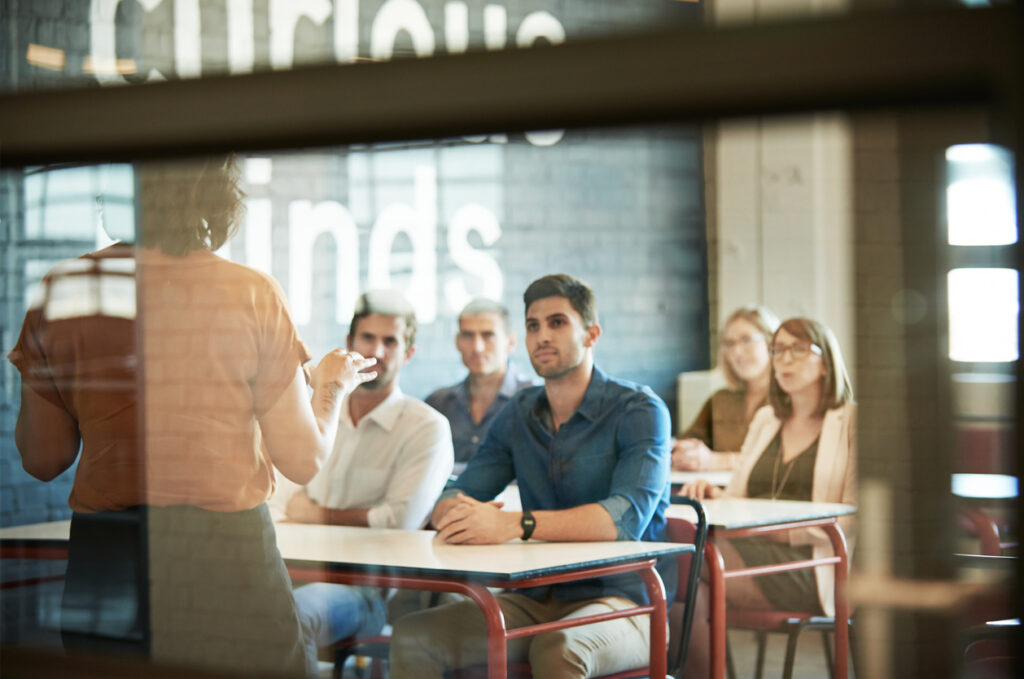While digital learning saves on costs, organisations are rediscovering the benefits of experiential learning and embracing a blended approach.
Economists will tell you that the ‘experience economy’ is thriving. Expenditure on live entertainment in the UK – such as the theatre, concerts, or events – has increased by a quarter since 2012.
You may well have noticed that businesses are starting to offer more experiential events: escape rooms, secret cinemas, sleepovers in museums, and ‘retail-tainment’ – all to satisfy the hunger for memorable, absorbing, and immersive experiences.
It seems counterintuitive then that for a while, learning and development – an industry that focuses on sustained knowledge retention – was moving away from memorable and immersive training and towards the merely functional.
The move to digital learning products was driven not just by a desire to save costs, but also by the perception that in today’s business environment we are all ‘time poor’.
The belief was that if bite-sized learning was delivered digitally, people could snack on it at their desks.
While digital learning might save time, however, experiential learning is time well spent.
More recently, we have been having conversations with clients who are expressing a need to move back towards classroom based experiential learning. We were interested to explore what may be driving this.
Experience the difference
The ancient Chinese philosopher Confucius expressed his belief in the importance of learning from experience when he wrote:
I hear and I forget
I see and I remember
I do and I understand
Confucius related the acquisition of understanding and knowledge directly to living and experiencing.
The original model for classroom learning was based on the monastic tradition – the methodology of the most senior monks reading from their reverential notes and then more junior monks scribing into their own books.
Many lectures today still seem to imitate this practice and become a process where the notes of the professor are transferred to the notes of the student, without knowledge ever passing through the mind of either.
Experiential learning is different from ‘chalk and talk’ lectures, and different from digital webinars and eLearning. The benefits on offer are an increased cognitive understanding, physiological rehearsal, and enhanced recall.
Emotions help you learn
Neuroscience can provide some answers here. Research conducted by Dr Stephan Hamann at Atlanta’s Emory University suggests that the role of emotions in the formation of memory is fundamental.
His findings from neuro-imaging, neuropsychological studies and neural stimulation indicated that emotions trigger specific cognitive and neural chain reactions which enhance memories.
For example, think of a time when you were particularly moved, or excited, or scared – doesn’t this memory feel more tangible and real in your mind?
Learning is always personal, existing only in the mind of the person who has been engaged on an emotional, intellectual, and behavioural level.
Professor Steve Mentz at St John’s University reached a similar conclusion – that in his experience, teaching at its core responds best to human encounters, and that learning is increased and accelerated by shared human connection.
Experiential learning is about getting higher levels of stimulation and instilling a quality of emotion in the event, which in turn increases the level of comprehension, recollection, and behavioural change.
Our experience with the experiential
Experiential learning, and in particular theatre-based learning, is based on the interplay between the experience and the individual, which means it is never standardised.
The learning is always personal, existing only in the mind of the person who has been engaged on an emotional, intellectual, and behavioural level.
No two participants have the same experience because each experience derives from the interaction between the training and the personal state of mind.
In blended learning packages, the digital platforms are used only to support and extend the personalised classroom learning event.
As a result, each learner still has significant memories of the course for years afterwards, as well as an enhanced relationship with the content, which aids recall and embeds the behavioural change.
These sessions also allow a safe space for participants to rehearse a variety of helpful and impactful behaviours – some more familiar than others.
Rehearsal accelerates the embodiment of these behaviours so that they become effective habits in a shorter amount of time.
Experiential learning moves the learner away from passive participation – which is encouraged by digital learning – and into a more active participation, which ensures that the training both absorbs and immerses the learner.
Interested in this topic? Read Classroom training: why do we still run instructor-led courses?
While digital learning saves on costs, organisations are rediscovering the benefits of experiential learning and embracing a blended approach.
Economists will tell you that the ‘experience economy’ is thriving. Expenditure on live entertainment in the UK – such as the theatre, concerts, or events – has increased by a quarter since 2012.
You may well have noticed that businesses are starting to offer more experiential events: escape rooms, secret cinemas, sleepovers in museums, and ‘retail-tainment’ – all to satisfy the hunger for memorable, absorbing, and immersive experiences.
It seems counterintuitive then that for a while, learning and development – an industry that focuses on sustained knowledge retention – was moving away from memorable and immersive training and towards the merely functional.
The move to digital learning products was driven not just by a desire to save costs, but also by the perception that in today’s business environment we are all ‘time poor’.
The belief was that if bite-sized learning was delivered digitally, people could snack on it at their desks.
While digital learning might save time, however, experiential learning is time well spent.
More recently, we have been having conversations with clients who are expressing a need to move back towards classroom based experiential learning. We were interested to explore what may be driving this.
Experience the difference
The ancient Chinese philosopher Confucius expressed his belief in the importance of learning from experience when he wrote:
I hear and I forget
I see and I remember
I do and I understand
Confucius related the acquisition of understanding and knowledge directly to living and experiencing.
The original model for classroom learning was based on the monastic tradition - the methodology of the most senior monks reading from their reverential notes and then more junior monks scribing into their own books.
Many lectures today still seem to imitate this practice and become a process where the notes of the professor are transferred to the notes of the student, without knowledge ever passing through the mind of either.
Experiential learning is different from ‘chalk and talk’ lectures, and different from digital webinars and eLearning. The benefits on offer are an increased cognitive understanding, physiological rehearsal, and enhanced recall.
Emotions help you learn
Neuroscience can provide some answers here. Research conducted by Dr Stephan Hamann at Atlanta’s Emory University suggests that the role of emotions in the formation of memory is fundamental.
His findings from neuro-imaging, neuropsychological studies and neural stimulation indicated that emotions trigger specific cognitive and neural chain reactions which enhance memories.
For example, think of a time when you were particularly moved, or excited, or scared – doesn’t this memory feel more tangible and real in your mind?
Learning is always personal, existing only in the mind of the person who has been engaged on an emotional, intellectual, and behavioural level.
Professor Steve Mentz at St John’s University reached a similar conclusion – that in his experience, teaching at its core responds best to human encounters, and that learning is increased and accelerated by shared human connection.
Experiential learning is about getting higher levels of stimulation and instilling a quality of emotion in the event, which in turn increases the level of comprehension, recollection, and behavioural change.
Our experience with the experiential
Experiential learning, and in particular theatre-based learning, is based on the interplay between the experience and the individual, which means it is never standardised.
The learning is always personal, existing only in the mind of the person who has been engaged on an emotional, intellectual, and behavioural level.
No two participants have the same experience because each experience derives from the interaction between the training and the personal state of mind.
In blended learning packages, the digital platforms are used only to support and extend the personalised classroom learning event.
As a result, each learner still has significant memories of the course for years afterwards, as well as an enhanced relationship with the content, which aids recall and embeds the behavioural change.
These sessions also allow a safe space for participants to rehearse a variety of helpful and impactful behaviours – some more familiar than others.
Rehearsal accelerates the embodiment of these behaviours so that they become effective habits in a shorter amount of time.
Experiential learning moves the learner away from passive participation – which is encouraged by digital learning – and into a more active participation, which ensures that the training both absorbs and immerses the learner.
Interested in this topic? Read Classroom training: why do we still run instructor-led courses?








